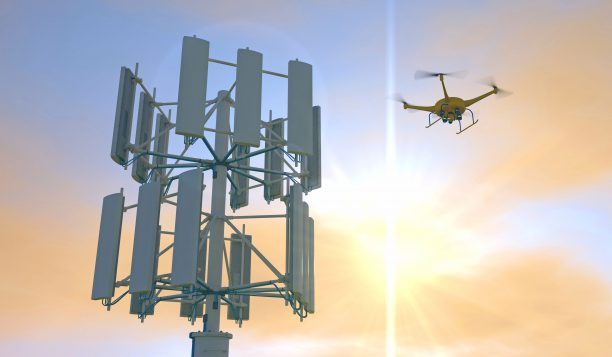Guest post by Colin Snow —

Drone inspection – Shutterstock
We just released a new research report titled “Five Valuable Business Lessons About Drones in Asset and Infrastructure Inspection” This is the fourth in a series of white papers intended to share lessons learned in specific industries and how to maximize the value drones can deliver in those industries. This year, we are building on the analysis we did for the 2016 “Truth About” papers by incorporating real-world experience gained from businesses and drone pilots operating under the Federal Aviation Administration’s Small Unmanned Aircraft Regulations (aka FAA Part 107).
In the report, which co-authored by Chris Korody, we demonstrate what drone operators servicing a wide variety of industries have learned about what works and what doesn’t. We explore both the benefits and limitations of drone inspection projects and offer practical advice to would be adopters. We answer questions like: What have companies learned about creating their own internal drone operation groups? And where do we go or what can we expect from here?
Here is an excerpt:
“While both media and investors have primarily focused on opportunities for using drones in the construction and agriculture industries, inspection applications have fostered innovation together with significant returns on investment. The reasons begin with the “four Ds”—a term coined by GE Ventures to describe the unique ability of drones to meet the needs of their field services customers. The four D’s describe any activity that’s tailor-made to be performed by a drone, and are:
- Dull
- Dirty
- Dangerous
- Distant
In a 2014 interview, Sue Siegel, the CEO of GE Ventures, added a fifth “D”—for data—saying simply, “Imagine that if you’re doing it faster, you might be able to do it more often. And more data typically will give you better data.”
The four Ds+1 combination is one of the most compelling arguments for drone adoption in companies where uptime is money, crews are expensive, and structures and facilities are often expected to last 50 to 100 years.
The other compelling argument is cost reduction. McKinsey Consulting’s recent white paper “Preserving the downturn’s upside” highlights how the oil and gas industry reduced costs by 29% in response to falling oil prices. They show that 40% to 50% of the savings came from eliminating the demand for a variety of services, including manned aviation support. The innovators figured out how to put drones to work.”
The report goes on to discuss how drones and the data from drones offer huge advantages in the oil & gas, telecommunications, and utility industries. It also provides insights from Dexter Lewis, PE, senior engineer in the research and development group at Southern Company (NYSOE: SO) which brings electricity and gas to 9 million customers.
You can get the free report here.
If you have questions about what’s in the report or would like to comment on it after reading it, write me at colin@droneanalyst.com.
Alan is serial entrepreneur, active angel investor, and a drone enthusiast. He co-founded DRONELIFE.com to address the emerging commercial market for drones and drone technology. Prior to DRONELIFE.com, Alan co-founded Where.com, ThinkingScreen Media, and Nurse.com. Recently, Alan has co-founded Crowditz.com, a leader in Equity Crowdfunding Data, Analytics, and Insights. Alan can be reached at alan(at)dronelife.com


New Research Report on Five Business Lessons about Drone Inspections
Guest post by Colin Snow —
Drone inspection – Shutterstock
We just released a new research report titled “Five Valuable Business Lessons About Drones in Asset and Infrastructure Inspection” This is the fourth in a series of white papers intended to share lessons learned in specific industries and how to maximize the value drones can deliver in those industries. This year, we are building on the analysis we did for the 2016 “Truth About” papers by incorporating real-world experience gained from businesses and drone pilots operating under the Federal Aviation Administration’s Small Unmanned Aircraft Regulations (aka FAA Part 107).
In the report, which co-authored by Chris Korody, we demonstrate what drone operators servicing a wide variety of industries have learned about what works and what doesn’t. We explore both the benefits and limitations of drone inspection projects and offer practical advice to would be adopters. We answer questions like: What have companies learned about creating their own internal drone operation groups? And where do we go or what can we expect from here?
Here is an excerpt:
“While both media and investors have primarily focused on opportunities for using drones in the construction and agriculture industries, inspection applications have fostered innovation together with significant returns on investment. The reasons begin with the “four Ds”—a term coined by GE Ventures to describe the unique ability of drones to meet the needs of their field services customers. The four D’s describe any activity that’s tailor-made to be performed by a drone, and are:
In a 2014 interview, Sue Siegel, the CEO of GE Ventures, added a fifth “D”—for data—saying simply, “Imagine that if you’re doing it faster, you might be able to do it more often. And more data typically will give you better data.”
The four Ds+1 combination is one of the most compelling arguments for drone adoption in companies where uptime is money, crews are expensive, and structures and facilities are often expected to last 50 to 100 years.
The other compelling argument is cost reduction. McKinsey Consulting’s recent white paper “Preserving the downturn’s upside” highlights how the oil and gas industry reduced costs by 29% in response to falling oil prices. They show that 40% to 50% of the savings came from eliminating the demand for a variety of services, including manned aviation support. The innovators figured out how to put drones to work.”
The report goes on to discuss how drones and the data from drones offer huge advantages in the oil & gas, telecommunications, and utility industries. It also provides insights from Dexter Lewis, PE, senior engineer in the research and development group at Southern Company (NYSOE: SO) which brings electricity and gas to 9 million customers.
You can get the free report here.
If you have questions about what’s in the report or would like to comment on it after reading it, write me at colin@droneanalyst.com.
Alan is serial entrepreneur, active angel investor, and a drone enthusiast. He co-founded DRONELIFE.com to address the emerging commercial market for drones and drone technology. Prior to DRONELIFE.com, Alan co-founded Where.com, ThinkingScreen Media, and Nurse.com. Recently, Alan has co-founded Crowditz.com, a leader in Equity Crowdfunding Data, Analytics, and Insights. Alan can be reached at alan(at)dronelife.com
See Also